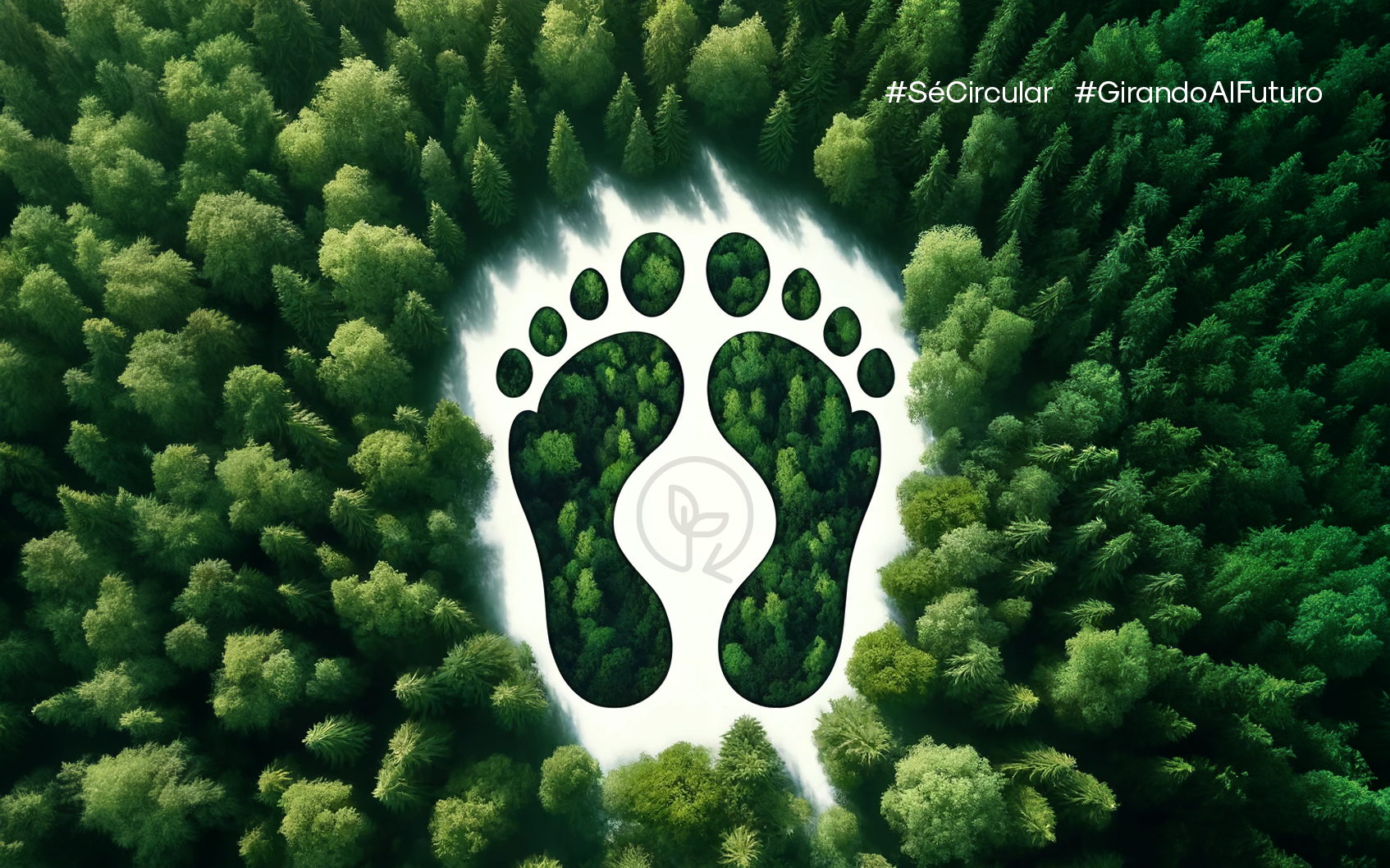
How big is your ecological footprint? Find out how you can reduce it today
Have you ever stopped to think about how much you affect the planet with your daily actions? You may not notice it, but from the shower you take in the morning to the dinner you prepare at night, it all adds up to your ecological footprint. So, what is that? Basically, it's a number that tells us how much of nature we need to live the way we live. In this post, we're going to walk you through what the ecological footprint is, how to calculate it, and why you should care so much about it. Let's discover together how our daily decisions impact the world and what we can do to not be part of the problem, but part of the solution. Get ready, because after reading this, you will see your habits differently.
What's up, what is the ecological footprint?
When we talk about ecological footprint, we are referring to a measure that helps us understand how much impact our existence has on the planet. Think of it as the trail you leave behind after a day at the beach, only instead of sand, we're talking about natural resources. The ecological footprint combines several aspects of our lifestyle, including the energy we expend when we turn on the lights or charge our cell phones, to the food we eat. It also considers the space needed to absorb the CO₂ we emit and the waste we generate. It's like a total tally of how much "living space" we need to maintain our current lifestyle. Knowing how much nature we need to live can give us a clue as to whether we are living sustainably or not. If everyone on the planet lived like the average person in some highly developed countries, we would need several planet Earths to sustain us. The ecological footprint helps us visualize this and pushes us to think about how we can make changes.

How does it relate to sustainability?
When we use more resources than our planet can replenish, we are basically taking out more than we put in. This can lead to big problems like deforestation. Imagine that by cutting down too many trees, we not only lose those CO₂-absorbing giants, but also the animals that call those trees home.
And it doesn't stop there, this imbalance also causes many species to be threatened by losing their place in the world, which contributes to the loss of biodiversity. In addition, this excessive rate of consumption warms the planet faster than normal, which changes the climate and affects every living creature, including us.
What can we do? Quite simply, make more conscious decisions about how we move, what we buy and how we dispose of what we no longer use. Reducing our overconsumption not only gives the planet a break, but also ensures a cooler, more sustainable place for everyone. It's time to balance the scales and take care of our only home, will you join the change?
Differences between ecological footprint and carbon footprint
Ecological footprint
Carbon footprint
- Measures the total impact on natural resources and the planet's regenerative capacity.
- Global hectares (gha).
- Includes the use of land, water, forests, fisheries, and waste generation.
- Evaluate whether our activities respect the planet's ecological limits.
- Indirect: assesses the overall impact on the environment.
- It focuses exclusively on greenhouse gas emissions.
- Tons of CO₂ equivalent (CO₂e).
- It only considers emissions of gases that contribute to global warming.
- Measure and reduce greenhouse gas emissions to combat climate change.
- Direct: quantifies the emissions that cause global warming.
Know the difference between ecological footprint and carbon footprint. carbon footprint helps us to understand the real impact of our actions and to identify specific areas where we can reduce our environmental impact. For example:
- If our goal is to combat climate change, we must focus on reducing our carbon footprint.
- If we want to protect biodiversity and ecological balance, it is essential to pay attention to our ecological footprint.
Both concepts are complementary and fundamental to building a more sustainable lifestyle.

How is the ecological footprint measured?
Measuring our ecological footprint is like checking how our actions impact the planet. Think of when you check how much data you use on your cell phone so you don't go over the limit, but in this case it's about natural resources: water, energy, food, everything we consume. It's like having a clear idea of how much we are asking from the planet to live our daily lives, and that helps us find ways to take better care of resources and reduce that impact.
What is considered in the measurement?
When we talk about measuring our ecological footprint, we are basically looking at everything we use and consume in our daily lives that has an impact on the environment. It's as if we were making a list of everything the planet needs to sustain our lifestyle. We explain the key points:
- Energy: This is all the electricity and fuel we use, whether at home, in the office, or when we drive or take transportation. Every time we turn on a light, use the air conditioning or fill up the car, we are leaving a mark.
- Water: Not only the water we drink, but also the water we use for washing clothes, bathing, cleaning the house or even watering the plants. It all adds up, and we often don't realize how much we are wasting.
- Food: What we eat has a huge impact, because producing food, especially meat, requires a lot of water, land and energy. For example, a steak has a much larger ecological footprint than a salad.
- Waste: All the waste we generate, from packaging to food scraps, affects the planet. It also matters a lot how we dispose of it, whether we separate it, compost it or just throw it all away.
Each of these factors counts in calculating our footprint, and understanding them gives us the opportunity to make changes that benefit the environment. It's like having a map of our impact so we know where to start caring more.
Tools to measure the ecological footprint
There are several tools and calculators available online that help us understand our impact. These calculators ask us for details about our consumption habits and lifestyle, and in return, they give us a figure that represents our footprint. If you are interested in calculating it, click here. Organizations such as the Global Footprint Network offer resources for individuals and companies to calculate their footprint and see where they can improve.
Why is this useful to know?
Knowing the size of our ecological footprint helps us identify where we are exceeding it and what changes we can make to reduce our impact. It's like having a map that shows us where we are and where we need to go to live more sustainably.
Understanding how our footprint is measured and what it entails puts us in a better position to make informed decisions that not only benefit the planet, but can also improve our quality of life by encouraging healthier and more sustainable habits.
The problem of having a large ecological footprint
Having a giant ecological footprint is like going shopping and filling the cart without paying attention to the price until we get to the checkout and realize that we have spent much more than we can afford. Only instead of money, we are spending natural resources, and the price to pay is borne by our planet.
Resource depletion
A large footprint means that we are consuming the planet's resources at an unsustainable rate. This can lead to shortages of essential materials such as fresh water and certain raw materials. When we deplete resources faster than they can regenerate, we risk running out of them in the future, which could lead to economic and social crises.
Climate change
Excessive ecological footprint also intensifies climate change. climate change. Overexploitation of fossil fuels for energy releases massive amounts of CO₂ into the atmosphere, accelerating global warming. This leads to extreme weather events such as stronger hurricanes, more intense heat waves and prolonged droughts that can devastate entire communities.
Loss of biodiversity
A disproportionate footprint also puts pressure on our ecosystems and the species that live in them. Deforestation to expand agricultural or urban areas, for example, destroys habitats and puts thousands of species at risk. This is not only a problem for nature; humans depend on biodiversity for food, medicine and even the air we breathe.
Conflicts and displacements
Finally, when resources become scarce due to our high demand, the potential for conflict increases. The struggle for resources such as water and land can lead to armed conflict and the displacement of populations, creating humanitarian crises.
A large ecological footprint can have severe consequences not only for the environment but also for our daily lives. It is crucial that each of us take steps to reduce our personal impact, thinking about the well-being of the planet and future generations. Reducing our footprint is more than an option; it is a necessity to ensure a sustainable future. Are you ready to review and adjust your footprint?

Tips on how to reduce the ecological footprint
Reducing our ecological footprint not only makes us feel better, but also allows us to move more freely and sustainably. Here are some practical tips to start easing that burden:
1.Optimizes energy use
One of the most effective ways to reduce your footprint is to minimize energy consumption. Consider switching to LED bulbs, which use much less energy than traditional bulbs. Take advantage of solar energy through solar panels if possible, and be sure to turn off electronic devices when not in use.
2. Reduce, reuse, recycle
Before buying something new, think about whether you really need it. If so, try to buy second-hand or reuse products. reuse what you already have. Recycle whenever you can and support companies that embrace the circular economy. circular economy by implementing sustainable practices in their production processes.
3. Choose sustainable transportation
Whenever you can, opt for greener modes of transportation. Bicycling, walking or public transportation are excellent alternatives to the car. If you need to use a vehicle, consider carpooling or, if possible, invest in an electric car.
4. Modify your diet
Meat production is one of the largest contributors to large ecological footprints due to its intensive use of land, water and energy. Reducing meat consumption and opting for a more plant-based diet can have a significant impact on reducing your footprint. Incorporate more fruits, vegetables, legumes and whole grains into your diet.
5. Support local producers
Buying local not only helps your community's economy, but also reduces the carbon footprint associated with long-distance transportation of produce. In addition, local produce is often fresher and less likely to require preservatives.
6. Education and awareness
Informing yourself and others about the importance of reducing your ecological footprint is vital. The more people know about the impact of their actions, the more likely they are to make conscious choices towards a more sustainable lifestyle.
Implementing these changes doesn't have to be complicated. You can start with small steps and gradually increase your efforts. Every small action counts and can add up to a big change towards a more sustainable future.
Conclusion on the ecological footprint
Reducing our ecological footprint is not something we are going to achieve overnight, and that's fine. The important thing is to start, to take those first steps that make us more aware of how we live and how we can improve. Sometimes it may seem that our actions are small, but if we all do a little, the impact becomes huge.
We ourselves have discovered that it's not about changing everything all at once, but about adopting more sustainable habits, one at a time. And yes, sometimes it's hard, but it feels good to know that we are taking care of the planet for ourselves and for generations to come.
Now the question is: where do you want to start? Maybe by turning off the lights, recycling more, or trying something new like composting. The important thing is that we make this change together.




